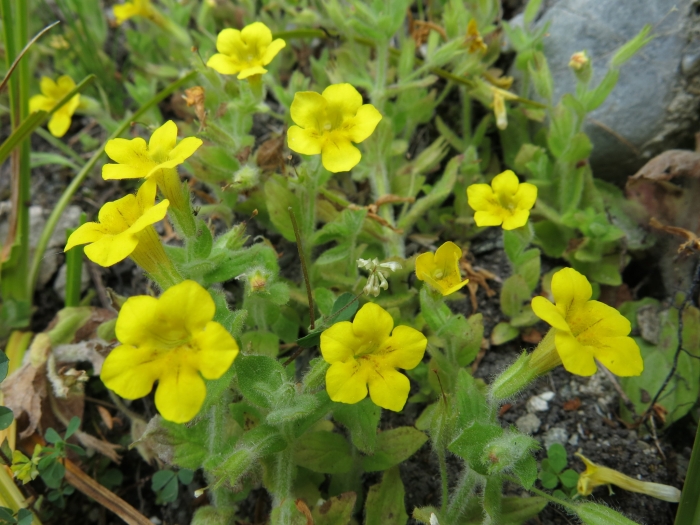Muskflower
(Erythranthe moschata)
Muskflower (Erythranthe moschata)
/
/

John Barkla
CC BY 4.0
Image By:
John Barkla
Recorded By:
Copyright:
CC BY 4.0
Copyright Notice:
Photo by: John Barkla | License Type: CC BY 4.0 | License URL: http://creativecommons.org/licenses/by/4.0/ | Rights Holder: John Barkla | Publisher: iNaturalist | Date Created: 2014-12-30T13:28:41-08:00 |




















Estimated Native Range
Summary
Erythranthe moschata, commonly known as muskflower or musk monkeyflower, is a rhizomatous perennial herb that is native to moist habitats such as stream banks, wet meadows, and seeps in western North America, from British Columbia through California and eastward to the Rocky Mountains. It has also naturalized in parts of eastern North America, Chile, and Europe. The plant typically has prostrate or upright stems that can reach up to 12 inches in length, and it bears yellow, tubular flowers that are mildly showy. The foliage was once noted for its musky fragrance, which has been absent in both wild and cultivated plants since around 1913.
Musk monkeyflower is valued for its ability to thrive in wet conditions and is often used in water gardens, bog gardens, and around ponds. It prefers partial shade but can tolerate full sun in cooler climates, provided it has ample moisture. The plant requires soils with good moisture retention and does not tolerate drought well. While it is not commonly grown for its scent anymore, it remains a charming addition to naturalistic plantings and can provide a naturalistic aesthetic to garden spaces. It is relatively low-maintenance but can be susceptible to powdery mildew and should be monitored for this disease.CC BY-SA 4.0
Musk monkeyflower is valued for its ability to thrive in wet conditions and is often used in water gardens, bog gardens, and around ponds. It prefers partial shade but can tolerate full sun in cooler climates, provided it has ample moisture. The plant requires soils with good moisture retention and does not tolerate drought well. While it is not commonly grown for its scent anymore, it remains a charming addition to naturalistic plantings and can provide a naturalistic aesthetic to garden spaces. It is relatively low-maintenance but can be susceptible to powdery mildew and should be monitored for this disease.CC BY-SA 4.0
Plant Description
- Plant Type: Herb
- Height: 0.5-2 feet
- Width: 1-2 feet
- Growth Rate: Moderate
- Flower Color: Yellow
- Flowering Season: Spring, Summer
- Leaf Retention: Deciduous
Growth Requirements
- Sun: Full Sun, Part Shade
- Water: Medium
- Drainage: Medium, Fast
Common Uses
Bee Garden, Bird Garden, Butterfly Garden, Deer Resistant, Hummingbird Garden, Low Maintenance, Water Garden
Natural Habitat
Moist habitats such as stream banks, wet meadows, and seeps in western North America
Other Names
Common Names: Musk Monkeyflower, Musk, Musk Mimulus, Muskflower, Mimule Musqué, Clustered Monkeyflower, Musk Plant
Scientific Names: , Erythranthe moschata, Erythranthe moniliformis, Mimulus crinitus, Mimulus dentatus var. gracilis, Mimulus guttatus var. moschatus, Mimulus leibergii, Mimulus macranthus, Mimulus moniliformis, Mimulus moschatus
GBIF Accepted Name: